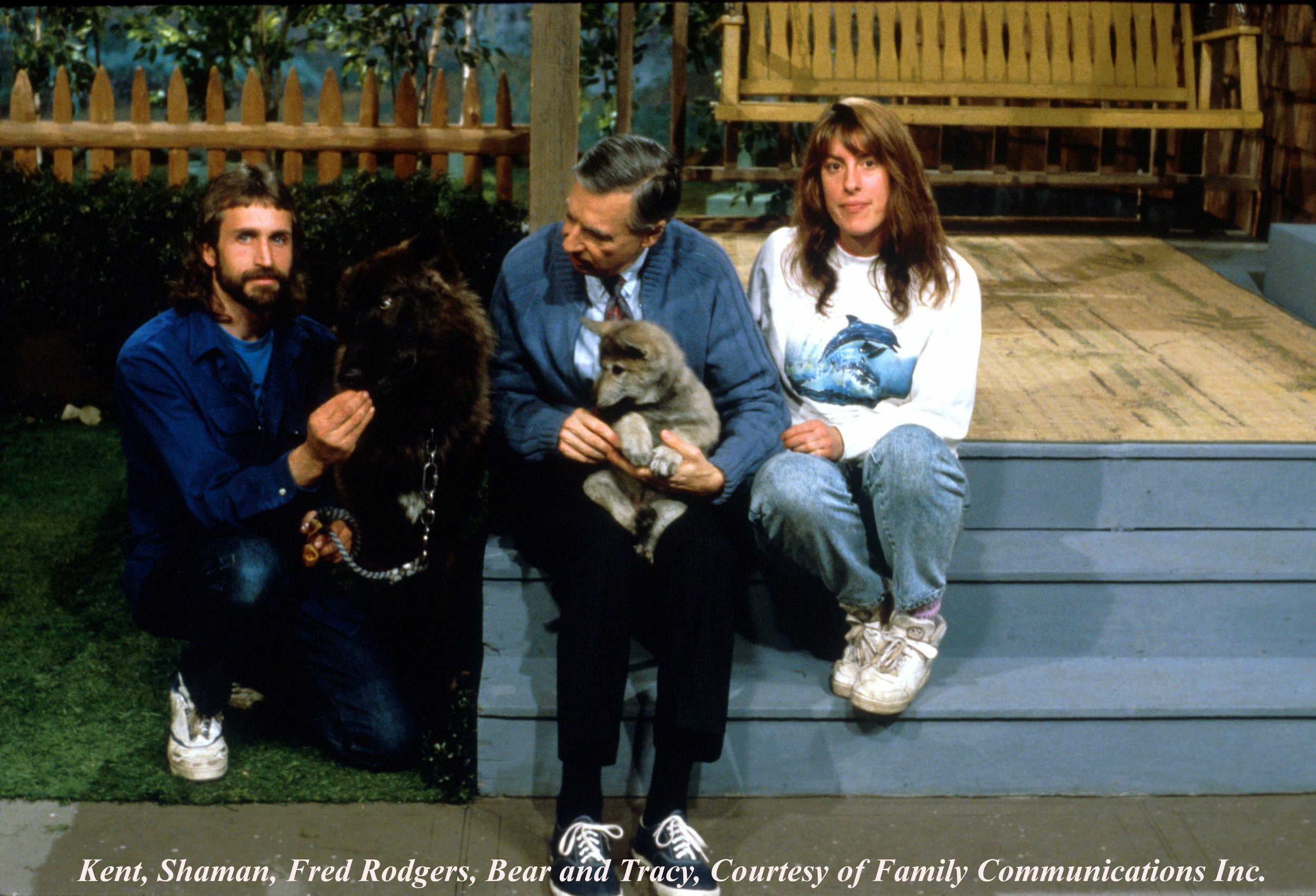Ambassador Wolf Tour
Mission:Wolf Co-founders Kent and Tracy along with wolves Shaman and Bear on Mr. Roger’s Neighborhood
Ambassador Wolf Program
We currently travel for special events within the Rocky Mountain region. Our nationwide program is on hold until further notice. You can contact us if you would like to be added to a waiting list.
Kent Weber, Mission:Wolf’s founder and director, has facilitated Ambassador Wolf programs for more than 20 years, leading wolves to greet over a million people from many different organizations, including:
• Government agencies: USFWS, NPS, NFS, BLM, USDA
• Conservation groups: Sierra Club, Audubon, National Wildlife Federation, Defenders of Wildlife
• Universities: Harvard, Cornell, CU, ASU, UNM, UVM
• Schools: Private, Public, Disabled, Colleges, Preschools
• Clubs: Boy’s & Girl’s, 4-H, Scouts of America
• Museums, Zoos, Nature Centers, Libraries, Law Firms, Corporations
• TV Specials including National Geographic, ABC, CBS, NBC, CNN, PBS, Mr. Rogers, the NBC Today Show, TV and radio talk shows.
Each program is structured to accommodate individual audience needs and interests. You can learn more about our education philosophy here.
The Ambassador Wolf program has proven to be very effective in stimulating people to care about environmental issues. We have also found that when people are given an opportunity to meet a live wolf, they will drive hundreds of miles to participate. This exposure can also result in increased awareness for the sponsoring group’s interests and needs.
Size of Audience
Groups of 10 to 5000 can be accommodated, depending on the facility’s ability to seat people comfortably. Due to time limitations and high interest, we suggest audiences ranging from 50 to 500 per program.
Suggested Program Length
• Preschool to 3rd grade: 25-40 min.
• 4th to 12th grade: 45-75 min.
• University/Public/Private: 60-120 min.
• Program length can be adjusted to fit individual schedules.
Funding
In order to provide education across the U.S., our wolves and staff travel long distances. To make this possible, program donations must help cover travel expenses. For most school and daytime events, we request a donation of $1,000 per event. A donation of $2,500 is appropriate for most universities, museums, and events offered to the public for free. Program hosts that charge for admittance to programs will split proceeds with M:W after the initial fee is paid. Program funds are due at the end of the program(s). Additional school programs at the same location may be offered at a reduced fee. Bartering of materials or services may be considered. Fees include a one year sponsorship of a wolf living at Mission:Wolf.
Marketing and Announcements
We have witnessed many programs sell out with only 24-hour notice. We have also arrived at large facilities to do highly-promoted events with only a handful of people present. It is not how long you spend preparing for the wolf’s arrival, but how you do it that tends to determine participation.
Key factors for success include:
A facility with adequate seating for people
A sponsor willing to host the program financially and help advertise it
These two generally come together in the same package. There are many groups and clubs whose primary mission is to host public educational events. The Ambassador Wolf program can be used as a fundraiser by charging admission to public events if necessary. Our purpose is to provide education, and we do not want to turn away interested people due to a lack of money. We suggest that hosts offer public events for free if possible. If the program is used as a fundraising event, we do not want the issue of fundraising to overpower the Ambassador Wolf program. If a group chooses to fundraise, the proceeds will be split evenly between the host and Mission:Wolf.
Many people find success by simply reserving an auditorium or gymnasium at the local college, school, museum, library, or other public meeting area. Student groups can generally do this for free and are often willing to help advertise events. Private individuals and clubs in the community are often asked to pay for the rooms and advertising. Once the location and date is secured, it becomes much easier to find additional partners willing to pay for and advertise the program.
Announce the Wolf’s Arrival
You may use photos from our website, or contact us for photos to make a flier to announce the date, location, time, and cost of the event. Make a few hundred full-sized copies, find a group of willing people, and ask each one to hang up and display 20+ fliers in their local neighborhood — community bulletin boards, businesses, food stores, schools, churches, etc. With permission from sidewalk owners, ask student artists to create sidewalk chalk paintings announcing the event. These efforts, along with word-of-mouth, can fill most facilities with ease.
Call the local newspapers, radio, and television studios to find out who should receive a press release announcing the event. The wolves may be available to do TV talk shows or news features at the studios. Newspapers usually like wolf photos and phone interviews. Be sure to ask each organization to list the program in the community bulletin or event columns. Follow-up is critical, or they may forget.
Once the location and host are secured, the rest of the details fall into place easily. Each town we visit is due to a single individual that achieved the items above. Some did it by themselves, while others simply delegated these duties to others and handled the follow-up to keep everything organized. Again, these are simply some tasks that we have seen produce a wonderful and memorable experience for everyone involved. Please contact Mission:Wolf with any questions/concerns, to be added to the waitlist for cross-country programs, or to schedule your program in the Rocky Mountain region.
